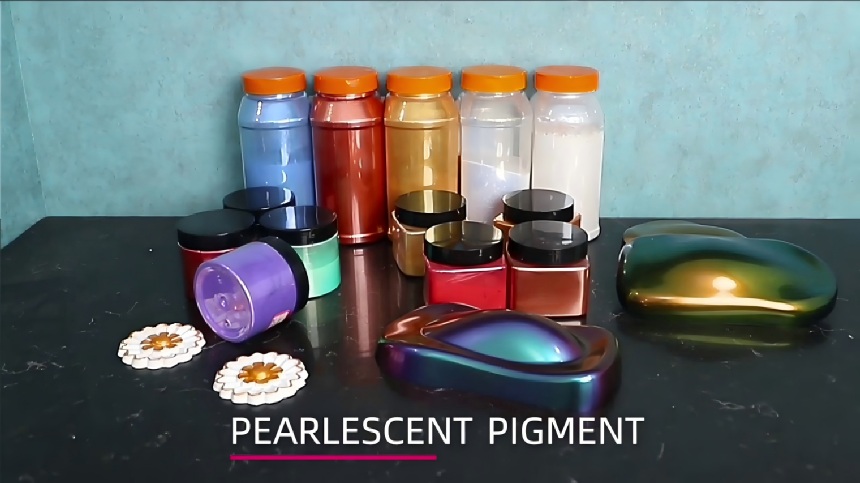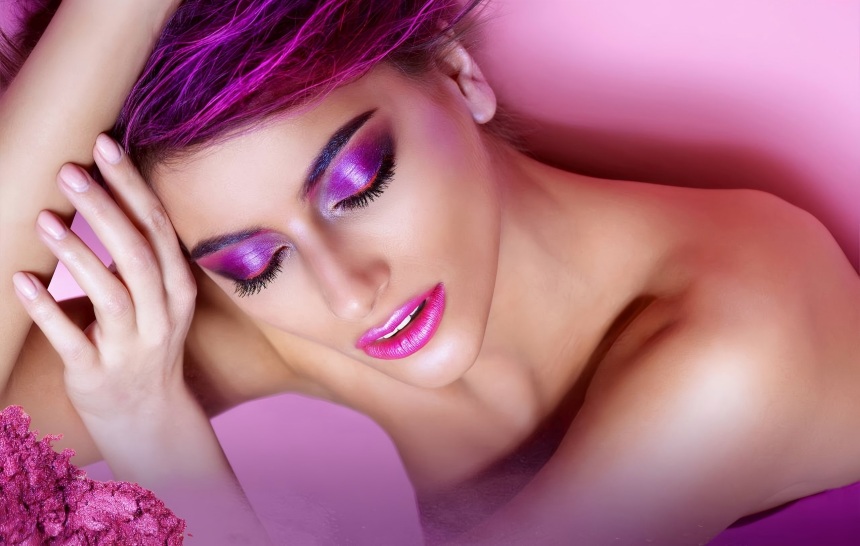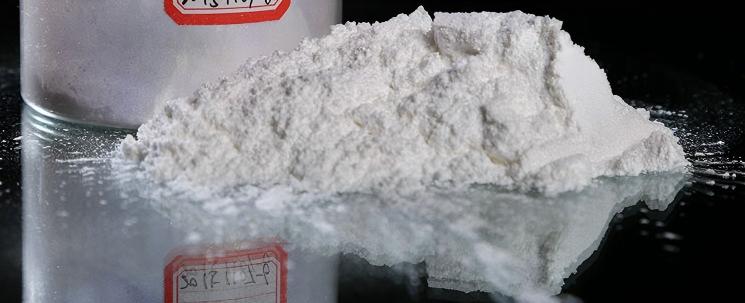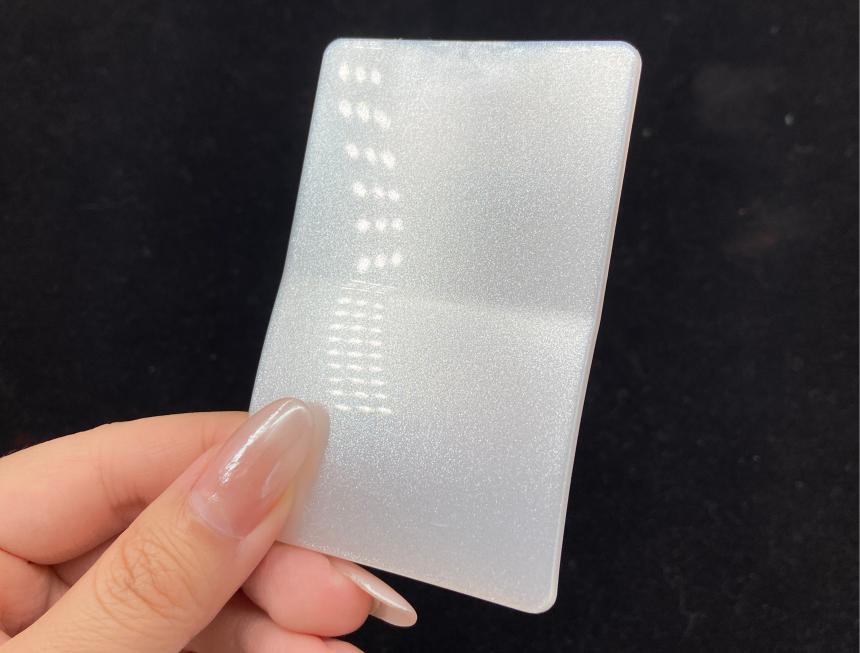Finding the Secrets of Selection and Application to Make Your Products Shine with a Premium Feel
The following information is compiled from a recording of a high-end pearlescent pigment exchange meeting in China 2025-10-31. The speaker is an engineer who has been engaged in the research and development and production of mica based pearlescent pigments for more than 20 years. He has witnessed the rise and fall of many major pearl pigment factories in China.
Part I: Characteristics and Business Promotion of Pearlescent Pigments
Product Positioning: Mica based Pearlescent pigments are a type of effect pigments which are also called mica powder, producing a lively and dynamic effect. They have neither the strong impact of metallic pigments nor the dullness of ordinary pigments.
Application Case (Apparel): Currently, pearlescent pigments have been introduced into apparel fabrics, especially in the coating of autumn and winter down jackets. Beyond pearlescent pigments, some functional pigments with thermochromic or photochromic properties can also be used in such coatings. This makes the visual effect of clothing more vibrant, thus appealing to younger consumers.

Pic# Thousands of colors series
Customer Identification in Business Promotion:
In business promotion, some customers are unsure whether the pigments they need belong to the pearlescent category and require our assistance in identification.
We often receive sampling requests from customers who send samples and ask us to match them with corresponding products within the pearlescent system.
We use various methods for identification, such as microscopic observation (the most direct method) and refractive index testing, to determine the category and provide solutions.
Product Line Advantages: iSuoChem's product line can meet the needs of most customers. Unlike companies that only focus on pearlescent pigments, our product line is more comprehensive. The key is to accurately identify customer needs and provide precise product solutions, thereby increasing the success rate of closing deals.
Part II: Microstructure and Substrate
Core Structure
Pearlescent pigments have a plate-like structure at the microscopic level.
The structure consists of two parts:
Inside: The central substrate (core).
Outside: One or more layers of the same or different metal oxides coating the outside.
The quality and gloss of pearl pigments are closely related to the substrate. Its various performance indicators are partly determined by the substrate and partly by the coating layer.
Emphasis on the Significance of the Plate-like Structure: We emphasize its plate-like structure because, during promotion, customers occasionally inquire whether we can provide "spherical pearlescent pigments." If this could be achieved, it would be a technological breakthrough, but the product might no longer fall under the category of traditional mica based pearlescent pigments.
Key Parameter: Aspect Ratio
The higher the aspect ratio (the ratio of particle diameter to thickness), the higher the quality indicators of the pearlescent pigment generally are.
For example, an aspect ratio of approximately 50:1 can create a silvery-white pearlescent effect; however, to produce high-end interference color products such as chameleon masks, a ratio of 100:1 or higher is required.
Natural mica is suitable for making chameleon products precisely because of its natural aspect ratio advantage.

Pic# Chameleon pearlescent pigments
Example of aspect ratio application (pearlescent pigments cosmetics): When developing eyeshadow products, products with a high aspect ratio should be prioritized.
Reason: High aspect ratio flakes adhere well to the skin, are easy to spread, and do not clump together. Conversely, low aspect ratio particles are like flour, tend to roll when spread, and cannot adhere evenly, affecting the makeup effect (workability). A grainy feel or easy shedding indicates poor workability. Therefore, choosing products with a high aspect ratio is crucial.
Characteristics and selection of different substrates:
Many customers have a general understanding of "what is mica based pearlescent pigment", but they are not clear about the specific substrates of mica.
Natural mica:
-
Source: Mined from deposits. For example, Indian deposits, mined by methods including manual drilling or blasting of thick layers. Natural mica has a layered structure similar to plywood.
-
Processing: Grinding the raw ore into thinner sheets is a challenging process. Excellent processing can separate even thinner flakes (high aspect ratio).
-
Characteristics: Brightness and color vibrancy of natural mica based pearlescent pigments are relatively average.
-
Limitations: Due to the presence of natural metal oxide impurities, its application is limited in fields with strict requirements for heavy metals (such as food contact materials).
Synthetic Mica: Higher purity, superior performance compared to natural mica, industry evaluation describes it as "whiter for white, more vibrant for colored."
Glass Substrate: Best transparency, highest shimmer.
Practical Application of Substrate Selection
When to Recommend Glass Substrate: If the customer's primary requirement is "higher shimmer," glass substrate products should be considered first.
White Paper Printing Case: When using natural mica-based pearlescent pigment on white paper, black spots may appear when viewed from certain angles after printing. This is due to its poor transparency; shadows may occur on both the sides and the front, becoming more pronounced with larger flake diameters. If the substrate is colored fabric, the shadows are acceptable; however, the whiter the substrate, the more pronounced the shadow problem.
Automotive Pearl Pigment Powder (Pearl pigments for auto paint) Coating Case Study: The curved surfaces of black sedans exhibit pearl luster interference colors (such as blue) under specific lighting conditions, while appearing pure black without direct light. If natural mica is used, the pearl pigment paint surface may appear to have dirt spots (gray spots) that cannot be wiped off due to its strong hiding power and poor transparency. High-end automotive pearl paints require glass-based substrates to achieve transparency, ensuring the base color is piano black, with the pearlescent effect only appearing under light.
Coating Layer Characteristics
Metal oxides (such as titanium dioxide and iron oxide) are deposited on the substrate surface in nanoscale molecular form through chemical reactions, unlike titanium dioxide which is physically mixed or pressed.
Relying on electrostatic adsorption, if not fully sintered and cured, friction may cause the coating layer to peel off (discoloration upon rubbing).
Different colors will be produced by using the same material but different numbers of layers, using different materials, or changing the coating order.
Difficulty of Imitation
Even with access to competitor product composition data (such as GPS/MSDS), reverse engineering is extremely challenging. Because process parameters (such as coating sequence) are unknown, successful replication depends on experience and a certain amount of luck.
Sales Tip
When facing customer replication requests, be cautious in your wording. Avoid promising "guaranteed replication success," and instead state "we can attempt replication and will do our best to achieve the goal."
Part III: Color Types and Formation Principles
Two main categories
Pearl pigments are mainly divided into solid colors and interference colors (virtual colors).
Solid Colors: The pigment's color is basically the same in its concentrated state (accumulated state) and after coating.
Interference Colors: The pigment appears white in its accumulated state, but after coating, it displays varying colors such as yellow, red, purple, blue, and green at specific angles.
Accurately identifying the color type is key to providing the correct product solution and improving the success rate of sampling.
Interference Color Formation Principle
Achieved by coating the substrate surface with metal oxides (such as titanium dioxide) of different thicknesses.
For example, coated titanium dioxide:
40-60 nm: Silver white mica powder
80-100 nm: Interference gold mica powder
As the thickness increases, the interference colors change sequentially to red, purple, blue, and green.
The chemical composition of interference green and silvery white is exactly the same, only the coating thickness differs.
Differences in white color
White mica powder exhibits hue differences, primarily bluish and white.
The market generally prefers bluish white because it appears whiter. Yellowish white appears slightly darker.
However, products with thicker coatings (yellowish) often have higher brightness. A thinner coating leads to excessive light transmission and insufficient reflected light, resulting in decreased brightness.
There is no absolute superiority or inferiority; it depends on the specific needs and application scenarios of the customer.
Responding to customer feedback of "not white"
It is essential to inquire in depth to pinpoint the root cause of the problem.
Key question: "What makes you judge that it's 'not white'?"
If the answer is "I felt it wasn't white when I opened the packaging and looked at the mica based pearlescent pigment powder (in its stacked state)," then a product that appears whiter (leaning towards a bluish hue) in its stacked state should be provided.
If the answer is "The reflected light doesn't appear white enough after spraying onto the board," the problem lies in the whiteness of the film layer. A product with a thinner (bluish) coating layer is needed, not a thicker one.
Generally, a thicker coating layer provides more coverage of the substrate's natural color, resulting in a whiter appearance (e.g., masking the gray undertones of natural mica).
Color mixing explanation
There are transitional colors between interference colors (e.g., interference orange between interference gold and interference red).
Theoretically, different interference colors can be mixed for color mixing, but note the following: Small particle size products are easier to color mix, while large particle size products tend to appear messy after color mixing.
Directly synthesized primary colors have higher purity and are more vibrant. Mixing colors usually leads to decreased color saturation, tending towards a duller appearance.
Part IV: Production Process and Quality Dimensions
Production Process
The complete process involves approximately 25 steps, resulting in a long production cycle.
Dedicated production of a single product typically takes three weeks.
Sales Tips: For custom orders or production to order, delivery time commitments should be made with caution, and a three-week production cycle should be fully considered.
Quality Dimensions
1. Batch Stability:
This is a core indicator for pearlescent pigments manufacturers.
Controlling batch stability for high-end products is extremely difficult (for example, even leading companies in the industry regularly handle non-conforming products).
The hydrolysis coating process itself is subject to fluctuations.
Stability assessments must be consistent with the customer's testing methods. For example, cosmetic customers are concerned about powder buildup color; if the factory uses injection-molded parts for assessment, the results may not be reliable. Understanding the customer's actual testing methods and application conditions is essential for effectively controlling quality consistency.

Pic# Purple cosmetic grade pearlescent pigments for makeup
2. Whiteness and Brightness: These two concepts are easily confused. What customers mean by "not white" sometimes actually means "not bright."
Customers need to be guided to clarify the difference: Whiteness relates to color purity, while brightness relates to the intensity of reflected light.

Pic# iSuoChem White Mica Powder
3. Hiding power:
Definition: The ability of a pigment to cover the color of the substrate.
Influencing Factors: Substrate type and coating process.
Product Example: Our "Polar White" series features high hiding power, combining high whiteness and high brightness.
Clarifying Misconceptions: Higher hiding power is not always better. It depends on the application. For example, automotive paints (Made by pearl paint pigment) aim for a transparent look; high hiding power can actually cause gray/black spots to appear on the front, affecting the appearance.

Pic# Polar White pearl pigments (Pearl dosage 1% in PP)
Other Application Case (Watracery Fabric)
This is major pearlescent pigment uses in the textile industry.
It is available in two widths: narrow (1-1.2 meters, for clothing) and wide (for home textiles and bedding).
Modern processes use engraved rollers to print the pearl pigments along with the colorant onto the fabric.
Dosage: On average, 30% of the area of this type of fabric uses pearlescent pigment, with an addition amount of approximately 15%. Our partner factories purchase in large quantities, often by the container.
FAQ
Is mica based pearlescent pigment safe to eat?
We've received numerous inquiries from clients asking, "Is mica-based pearlescent pigment edible?" or "Is mica-based pearlescent pigment safe?"
Yes. We can assure you: It is an absolutely safe effect pigment. But it's not recommended for edible uses.
As a pearlescent pigment supplier for nearly 20 years, we have many products comparable to Merck pearlescent pigments. We've also encountered overseas clients requesting matching products from domestic and international brands and labels, such as Pearl EX pigments, CQV pearlescent pigments, Eckart synthetic pearlescent pigments, EMD pearlescent pigments, Kuncai pearlescent pigment, or other brands.
Currently, none of these suppliers can provide so-called edible pearlescent pigments.
However, Mica-based pearl pigments are indeed harmless to the human body, cannot be absorbed, and even if accidentally ingested, will be excreted through feces. Even under stricter standards, the heavy metal content and microbial indicators of our effect pigments are far below EU cosmetic standards. However, we still do not currently recommend the pearlescent pigment uses in any food contact applications




